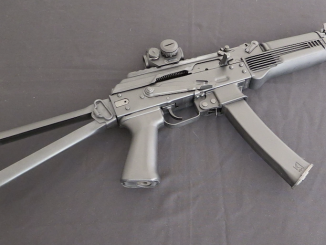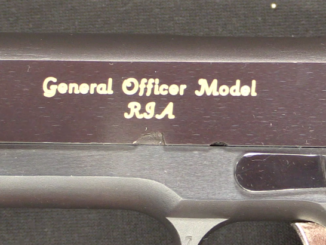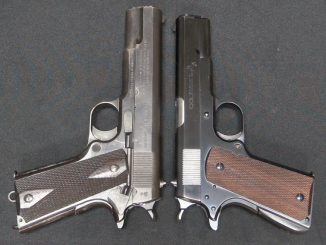C.S. Shattuck’s “Unique” squeeze pistol is one of the last of this sort of sightless, underpowered hideout guns. Its core patent was actually filed by Oscar Mossberg, who worked for Shattuck before setting up his own company, which you are much more likely to have heard about today! Mossberg would refine the concept after World War 1 into the Mossberg Brownie, but that is a topic for another day.
Shattuck produced a few thousand of these squeeze-fire guns, primarily chambered for .22 and .32 rimfire, although there were a small number also made in .30 rimfire. They are all 4-barrel guns, with a rotating firing pin that discharges the rounds sequentially, one per squeeze. This particular example is a .32 caliber one, which used a slightly larger frame than the .22s.




US patent , 837 867
Patent describes an extractor and different lock up however.
“.32 rimfire”
Interesting choice, patent pointed by Strongarm (which can be seen here: http://www.google.com/patents/US837867 ) has Filling date, Dec 4, 1906 at this time I would rather except .32 Auto (which should work thanks to semi-rimmed case) or .32 S&W Long or .32 S&W (which if I am not mistaken was popular at that time)
“sightless”
For sightless automatic pistol of same era, without sights see Webley & Scott M1907 (for .25 Auto): http://tonnel-ufo.ru/eanglish/weapon/pistol-webley-scott-m-1907.php
Oi. The “trigger” action makes me think that accuracy would not be the best. Not that it needed to be, given its purpose. I think the later Mossberg Brownie would be a better choice.
The way the weapon would have to be gripped to fire would pretty much eliminate any “sighting”.
The most reasonable assumption is that when a footpad would wave a knife at you and demand your wallet, you reach into your outside coat pocket, grip this thing from above, and fire through the coat pocket without removing it from same, let alone anything like “sighting”.
The Colt “National” Derringer;
http://americansocietyofarmscollectors.org/wp-content/uploads/2013/05/B053_Lewis.pdf
http://www.antiquearmsinc.com/images/national-deringer-number-1-moore-derringer-colt-1st-single-shot-41-rimfire-engraved-silver-plated/national-deringer-number-1-moore-derringer-colt-1st-single-shot-41-rimfire-engraved-silver-plated-2.jpg
Designed by Daniel Moore in 1864-65 was most likely intended for a similar firing method.
The National really cannot be gripped “normally”; the only grip that really works is with the palm of the hand above the breech, the forefinger wrapped around the squared frame front below the barrel, and the second finger on the actual trigger, with the third and pinky fingers curled around the abbreviated grip. Again, this would be consistent with a gun intended to be cocked and fired from within a coat pocket.
The National Derringer’s front sight was, I suspect, mainly there for aesthetics, i.e. people expected a front sight on a pistol. I believe that even when cocked, the hammer neatly obscures it from behind.
In either case, accuracy is going to be nearly nonexistent. At the ranges in question (probably under 3 feet), I doubt it would matter very much.
cheers
eon
“coat pocket without removing”
This might explain such choice of construction – as alternative to special form of automatic pistol allowing one-hand reading to fire like in Praga 1921 automatic pistol (.25 Auto) with special shape of slide:
http://forum.valka.cz/topic/view/112091/CZK-Praga-1921
or SIG Chylewski which can be cycled by pressing what appears to be trigger guard at first glance.
Also the Little All Right pocket revolver;
https://www.forgottenweapons.com/ria-little-all-right/
Which really has no provision for “sighting”, period, considering that its trigger (or “pull” as the manufacturer called it) is on top of the barrel.
It also folded down over the muzzle, less as a safety provision than just to keep pocket debris like lint out of the bore.
It was to be fired with the “grip” pressed against the palm or more exactly the mount of Venus, i.e. the “hump” at the base of the thumb.
While it could be fired at full arm extension, it was more likely intended for “point shooting” with the elbow pressed into the ribcage, or even from inside a pocket.
cheers
eon
“Which really has no provision for “sighting”, period, considering that its trigger (or “pull” as the manufacturer called it) is on top of the barrel.”
In some European pocket automatic pistol made before World War II, groove in top, instead of “normal” sights can be found, example might be UNIQUE Model 10 automatic pistol for .25 Auto cartridge, see photo here: http://dwsuk.org/Unique-Model-10-25ACP
From more modern automatic pistols OTs-21 has sights: groove
http://gunrf.ru/rg_pistol_OTs-21_eng.html states that
Pocket pistols are usually used for snapshots at a range of 7 to 10 m, and such simple sights are quite sufficient at such short ranges.
Interestingly sights: groove can be also found on BAYARD Mle. 1923 automatic pistol of Belgian origin, see 3rd photo from top here:
http://zonwar.ru/pistolet/Bayard-1923.html
It was made in .32 Auto and .380 Auto (smaller version for .25 Auto also existed). It looks similar to FN 1910, but differ in having hammer group designed by Bernard Clarus.
When firing in a hurry, care for thumbs.
The Shattuck Unique extractor/ejector is a pull-tab metal toothpick stored in a notch on the right side of the pistol. The RIA example has the tool in its proper place.
Mightn’t you hold it “upside down,” barrels between index and middle fingers, and press the trigger with your thumb?
thanks a lot